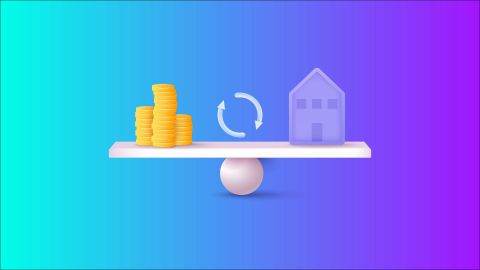Buying a home is a significant financial undertaking, and for many, securing a home loan is an essential step in realising this dream. Over the years, financial institutions have introduced innovative features to make home loans more flexible and convenient for borrowers. One such feature gaining popularity is the "home loan with overdraft facility."
What is a home loan with an overdraft facility
A home loan with overdraft facility is a specialised financial product that combines the features of a traditional home loan with the flexibility of an overdraft account. In a standard home loan, borrowers are provided with a lump sum amount for the purchase of a home, and they repay the loan through fixed Equated Monthly Instalments (EMIs) over a predetermined period. However, a Home Loan with an overdraft facility introduces a unique twist to this conventional model.
How does a home loan overdraft facility work
The functioning of a home loan with an overdraft facility is quite straightforward. Once a borrower is approved for the loan, the sanctioned amount is deposited into an overdraft account linked to the home loan. This account acts as a pool of funds from which the borrower can withdraw any surplus amount over and above the EMI payments.
1. Loan sanction and overdraft account setup:
- Once a borrower is approved for a home loan with an overdraft facility, the sanctioned loan amount is deposited into an overdraft account linked to the home loan.
- The overdraft account acts as a pool of funds from which the borrower can withdraw any surplus amount over and above the regular EMI payments.
2. Flexibility in fund management:
- Borrowers have the freedom to withdraw funds from the overdraft account as needed, similar to how one would access funds from a regular overdraft facility.
- This flexibility allows borrowers to use the surplus funds for various purposes, such as home renovations, emergencies, or other financial needs.
3. Interest calculation on utilised amount:
Interest is charged only on the amount withdrawn from the overdraft account. This is in contrast to traditional home loans where interest is calculated on the entire sanctioned amount, even if it is not fully utilised.
4. Repayment and prepayment:
- The borrower is required to make regular EMI payments based on the outstanding loan amount.
- There is typically no penalty for making prepayments or repaying the loan before the agreed-upon tenure, providing greater flexibility in managing the debt.
5. Interest savings and financial management:
The home loan with overdraft facility offers potential interest savings for borrowers who are diligent in managing their finances. By maintaining a lower outstanding balance in the overdraft account, borrowers can reduce the interest burden.
6. Tax implications:
It is important to note that the tax benefits associated with a home loan with an overdraft facility may differ from those of a traditional home loan. Borrowers should consult with tax professionals to understand the specific implications in their jurisdiction.
7. Suitability for specific borrowers:
This financial product is particularly suitable for individuals with fluctuating incomes, those anticipating windfalls, or those who desire greater control over their finances.
Pros of overdraft facility in a home loan
Withdraw the surplus fund as needed: One of the primary advantages of the overdraft facility is that it provides flexibility in managing finances. Borrowers can withdraw additional funds whenever required and pay interest only on the amount withdrawn.
Avoid prepaid penalties: Traditional home loans often have prepayment penalties if the borrower decides to repay the loan before the agreed tenure. With an overdraft facility, there is no such penalty, allowing borrowers to pay off the loan faster without incurring extra charges.
Ability to repay the loan before the agreed tenure: The flexibility of an overdraft facility enables borrowers to make partial or full prepayments, reducing the overall interest burden and helping them become debt-free sooner.
Cons of overdraft facility in a home loan
For specific borrowers: The overdraft facility might not be suitable for everyone. It is more beneficial for individuals with fluctuating incomes or those expecting windfalls, as it allows them to manage their finances more efficiently.
Higher interest rates: home loan with an overdraft facility often comes with a slightly higher interest rate compared to traditional home loans. Borrowers must carefully weigh the flexibility offered against the increased cost.
No tax benefit: Unlike regular home loans, where borrowers can avail tax benefits on both principal and interest repayments, the overdraft facility might not offer the same tax advantages. This is an important consideration for those looking to optimise their tax planning.
Should you use an overdraft or a normal home loan
Choosing between a Home Loan with overdraft facility and a traditional home loan depends on individual financial goals and circumstances. If flexibilities in managing funds and potential interest savings are top priorities, an overdraft facility might be more suitable. However, if securing the lowest interest rate and maximising tax benefits are essential, a standard home loan could be the better option.
In conclusion, a home loan with an overdraft facility can be a valuable financial tool for those who prioritise flexibility in managing their home loan repayments. While it comes with its set of pros and cons, borrowers need to carefully evaluate their financial situation and future plans before opting for this innovative product. As the lending landscape evolves, the home loan with overdraft facility stands out as a unique offering that caters to the changing needs of home buyers.




